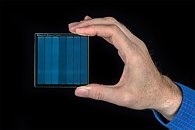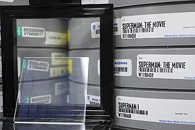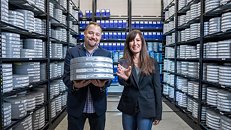Tuesday, November 5th 2019

Microsoft Unveils Project Silica, a Durable Silica Glass-based Optical Storage Media
Microsoft's cloud computing business unveiled Project Silica, a cold-storage device that's designed to stand the test of time. Essentially an optical storage media, it is a 7.5 cm x 7.5 mm x 2 mm square piece of glass that can store up to 75.6 GB of data (inclusive of error-correction code). Unlike conventional optical media such as CD or Blu-ray, which relies on etching pits of different lengths on a plastic substrate to denote ones and zeros, project silica uses nanoscale gratings and deformations, while AI is used for error-correction to overcome any aging of the media. The company developed a proof-of-concept using quartz glass.
"A laser encodes data in glass by creating layers of three-dimensional nanoscale gratings and deformations at various depths and angles. Machine learning algorithms read the data back by decoding images and patterns that are created as polarized light shines through the glass," writes Microsoft in its description of how Project Silica works. CD can typically hold data for 1-2 centuries provided that the disc is stored properly. After that, the plastic physical layer decays, losing data integrity. Project Silica, on the other hand, is designed to be resilient not just in a box, but also outside it. The media can "withstand being boiled in hot water, baked in an oven, microwaved, flooded, scoured, demagnetized and [withstand] other environmental threats that can destroy priceless historic archives or cultural treasures if things go wrong," says Microsoft.So what does a cloud computing company have to do with a super-durable optical storage media? Everything. We predict Microsoft could to pitch Project Silica as its proprietary high-endurance cold-storage medium to customers who want it. This will come especially handy for customers like the U.S. Military, which recently contracted Microsoft to build the JEDI Cloud. Project Silica isn't just on paper, Microsoft Azure has been able to successfully store and retrieve the Warner Bros film "Superman" on a proof-of-concept made of quartz glass. The company will work with Warner Bros to eventually copy its vast asset library spanning hundreds of films across thousands of film reels, onto the new media.
Source:
Microsoft
"A laser encodes data in glass by creating layers of three-dimensional nanoscale gratings and deformations at various depths and angles. Machine learning algorithms read the data back by decoding images and patterns that are created as polarized light shines through the glass," writes Microsoft in its description of how Project Silica works. CD can typically hold data for 1-2 centuries provided that the disc is stored properly. After that, the plastic physical layer decays, losing data integrity. Project Silica, on the other hand, is designed to be resilient not just in a box, but also outside it. The media can "withstand being boiled in hot water, baked in an oven, microwaved, flooded, scoured, demagnetized and [withstand] other environmental threats that can destroy priceless historic archives or cultural treasures if things go wrong," says Microsoft.So what does a cloud computing company have to do with a super-durable optical storage media? Everything. We predict Microsoft could to pitch Project Silica as its proprietary high-endurance cold-storage medium to customers who want it. This will come especially handy for customers like the U.S. Military, which recently contracted Microsoft to build the JEDI Cloud. Project Silica isn't just on paper, Microsoft Azure has been able to successfully store and retrieve the Warner Bros film "Superman" on a proof-of-concept made of quartz glass. The company will work with Warner Bros to eventually copy its vast asset library spanning hundreds of films across thousands of film reels, onto the new media.




26 Comments on Microsoft Unveils Project Silica, a Durable Silica Glass-based Optical Storage Media
I'm guessing it's very slow to read the data and even slower to write it though.
But pleeeeze, somebody knock Microsloft upside their collective heads and make it work with open standards, not more of that proprietary, closed-off bullcrap of yesteryear......
On a serious note I do wonder what resolution they use to digitize these negatives.
Even then though, sure, the actual technology used to manufacture this might have existed in some form for some time, but that's not really the point. Books are technically just "slapping some bug paste onto dead tree". Does that make the printing press the same thing as a calligrapher? Of course not.
Most technologies are built on principles that were well understood, and even in use for decades/centuries before something revolutionary came along like say, printing, instead of handwriting. This sounds like they're taking laser etching and taking it much, much further, in order to create essentially indestructible, non-degrading data storage.
I can imagine that with tech like this, it would be dramatically more difficult to damage than any previous medium, and even if in some freak circumstance your little glass tablet of data got scratched or chipped, it would be possible, as long as the crack didn't reach to the data layer inside, to subsequently polish it up to an optical standard again, recalibrate for the change in refraction, and rehabilitate the media back into a readable state. That's exciting stuff for the idea of data permanence. I can't think of any other medium remotely that resilient.
7.5x7.5x0.2 for 75.6GB of Data is 6.72GB/cm3, and it's being implied (Though not outright stated) here that these things will last for centuries.
Compare that to an IBM "Advanced Data Cartridge", which is 4TB native capacity, but 2.45 x 10.9 x 12.5cm, so 11.982GB/cm3 and has a lifespan of 30 years.
The tradeoff here is that you archive once, you store it forever. It costs more per glass piece, and you need twice as many, but if you're worried about the manpower and maintenance problems involved in re-archiving 30 years of data originally stored via a tape solution, this could massively reduce your operational cost while improving reliability and robustness of your backups.
On the other hand, I very much doubt this will be consumer tech any time soon, as it's a type of WORM drive.
example: upload.wikimedia.org/wikipedia/commons/c/c5/Laser_glass_sculpture_caffeine_molecule.jpg
I would buy it immediately once it is available for a reasonable amount of money.
Today I use multiple HDDs to store my family pictures and videos. They need to be maintained as HDDs eventually die.
This technology would solve the issue.
Companies would use it for weekly backup.
If they can manufacture it in quantity every PC will have it.
No place for everyithing.